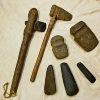theotherwaldo
Member
I've finally picked up some proper copper knives. They are close duplicates of those buried with the Amesbury Archer at about 2300 b.c., roughly contemporary with the erection of Stonehenge, which was not too far away.
Here's the grave, as found:

-and here are the three copper knives:

You'll notice that their shapes and proportions are almost identical to flint knives of the same size and period.
Anyway, I've picked up copper blades that are probably almost identical to how these blades looked when new, 4300 years ago. My problem is, no one knows what the handles or sheaths looked like.
I'm thinking about keeping it simple - I've got some chunks of one-hundred-plus-year-old oak flooring that I'll grind and burn to shape and mount up with birch bark glue, finishing off with appropriate bits of leather.
Anybody have any input?
Here's the grave, as found:

-and here are the three copper knives:

You'll notice that their shapes and proportions are almost identical to flint knives of the same size and period.
Anyway, I've picked up copper blades that are probably almost identical to how these blades looked when new, 4300 years ago. My problem is, no one knows what the handles or sheaths looked like.
I'm thinking about keeping it simple - I've got some chunks of one-hundred-plus-year-old oak flooring that I'll grind and burn to shape and mount up with birch bark glue, finishing off with appropriate bits of leather.
Anybody have any input?



